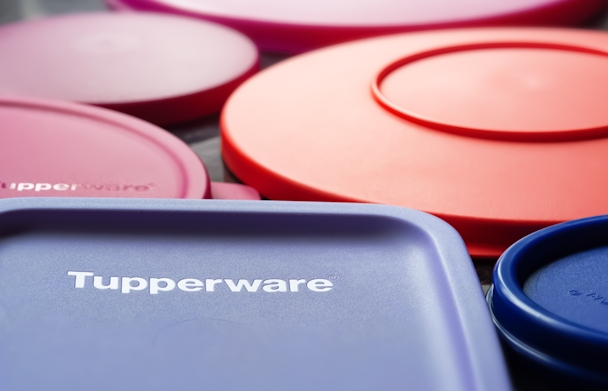Is the Tupperware party over? Unpacking the brand’s decline – and what could save it
Tupperware faces a turbulent chapter with its recent Chapter 11 filing, as shifting consumer habits and fierce competition challenge the once-revolutionary brand. Yet, with its deep-seated brand equity and a potential pivot towards digital innovation and sustainability, experts believe there might just be a recipe for revival.

Tupperware filed for Chapter 11 bankruptcy on Tuesday / Credit: Adobe Stock
Tupperware Brands, the iconic American company synonymous with food storage receptacles and the popular ’Tupperware parties’ of the 1950s, officially filed for Chapter 11 bankruptcy on Tuesday.
Once a symbol of suburban prosperity and women’s empowerment, the brand has struggled to maintain relevance in recent years due to changing consumer habits, rising competition and missed opportunities to innovate.
In a warning issued last month, Tupperware flagged significant liquidity concerns, raising doubts about its ability to continue operating. The company now carries $812m in debt, much of which was acquired by distressed debt investors at a steep discount in July, according to court filings. It has also faced several consecutive quarters of declining sales.
As chief restructuring officer Brian Fox acknowledged in a court filing, “nearly everyone knows what Tupperware is, but fewer people know where to find it.”
With the brand’s future in question, many are left wondering how Tupperware lost its market dominance and whether there is a way forward for the storied company.
Want to go deeper? Ask The Drum
A party that defined an era
Founded in 1946 by Earl Tupper, Tupperware became a cultural symbol of postwar American life. The brand was catapulted into the spotlight by American saleswoman Brownie Wise, who popularized the idea of direct-to-consumer (D2C) sales parties in the 1950s. During these events, women would host gatherings in their homes and demonstrate the products, providing housewives with financial independence while helping the company build a loyal customer base.
Another legacy D2C brand that built its empire through independent women representatives was Avon, the beauty company formed in 1886. The company’s iconic ’Avon Ladies’ sold cosmetics door-to-door, while Tupperware became famous for its home party sales model. And Avon may have been a harbinger for Tupperware; it too filed for Chapter 11 bankruptcy this summer, burdened by mounting debt tied to talc-related lawsuits.
Advertisement
“Direct-sales companies like Avon, Mary Kay and Tupperware have struggled to compete against the rise of digital and e-commerce platforms,” explains Tim Peters, chief marketing officer at software provider Enghouse Systems. “The Tupperware party, once a symbol of middle-class prosperity, no longer fits the modern consumer’s lifestyle, where convenience, speed and accessibility are paramount.”
Evolving consumer behavior, from living rooms to e-commerce
Tupperware’s D2C sales model began to lose relevance as consumer behavior began to shift in the dot-com boom. According to NPD Group data, only 9% of consumers today engage in in-home parties, compared with over 25% in the early 2000s.
“These in-home gatherings, which were a social and effective method for selling products in the 1960s and 1970s, became less relevant as e-commerce and retail environments evolved,” says Riani Kenyon, anthropologist & behavioral analyst at consumer insights agency Canvas8. “With the rise of digital shopping and more flexible purchasing options, customers moved away from the party-based model, preferring the convenience of online marketplaces or stores where they could quickly compare prices and products.”
Modern consumers expect the convenience of online shopping, fast delivery and subscription models – an evolution that Tupperware was slow to adapt to. The company’s efforts to invest in its online presence began in earnest in the 2020s. The brand opened an Amazon storefront in June of 2022 and its products were available on Target.com later that year. As a result, only 14% of Tupperware’s sales came from e-commerce in 2022, according to the company’s fourth quarter and full year 2022 results, compared with 65% for its primary competitors.
Advertisement
“Tupperware – probably for the best of reasons, attempting to protect their loyal sellers – was absurdly late to the e-commerce game,” says Jennifer Silverberg, chief executive officer of SmartCommerce, a martech platform.
Plus, she points out that the company’s website is outdated and offers consumers a lackluster experience. “The site they have today is simply a ‘catalog’ view of their products, without any supporting lifestyle content or reasons for buying.”
Silverberg observes that Tupperware’s bankruptcy filing indicates a “lack of experience in the e-commerce space.”
In its court filing, the company notes that when a customer searches for ’Tupperware’ on Amazon, the site “return[s] results for other brands, undercutting the Company’s strategic purpose for selling on Amazon.”
This attitude in itself represents a shallow understanding of the landscape, Silverberg suggests. “Any e-commerce marketer knows this is simply how Amazon works,” she says.
In an attempt to succeed in more traditional retail settings, Tupperware briefly partnered with HomeGoods and Bed Bath & Beyond in 2022. But the push arrived past due.
“While the company did eventually partner with major retailers and ramp up its online presence, these efforts were late and failed to maintain their original market hold,” explains Ross Kernez, a marketing and SEO strategist.
How competition sealed Tupperware’s fate
Tupperware’s golden years were defined by its innovative products – with their airtight seals, durable plastic and versatile containers that became kitchen staples. But as time went on, the company struggled to keep pace with market competition. New entrants like Rubbermaid and Ziploc offered similar food storage solutions at lower price points and through more accessible channels, like Amazon and big-box retailers.
Meanwhile, the global food storage container market continued to grow at an annual pace of 6.5%, per Research and Markets, yet Tupperware’s share dwindled from 8% in 2015 to less than 3% by 2023.
Suggested newsletters for you
Moreover, kitchen storage products became more eco-friendly, representing yet another missed opportunity for Tupperware. Research from NielsenIQ shows that 73% of Gen Z consumers prefer multifunctional, eco-conscious products.
“Many consumers associated [Tupperware] with old-fashioned plastic storage, a perception that became increasingly negative as awareness around the environmental impact of plastic grew,” explains Kernez. “Tupperware could have invested in developing innovative, eco-friendly alternatives, such as biodegradable or plant-based storage options, to stay competitive.”
Peters echoes this sentiment, noting that Tupperware’s attempts to modernize were often too little, too late. “The absence of substantial product innovation was a major missed opportunity,“ he says, adding that the company’s sustainability initiatives “felt reactive rather than innovative.”
He gives the example of Rubbermaid’s Brilliance line, which focused on BPA-free materials and fully recyclable products and launched in 2012, well before Tupperware’s sustainability push in 2019.
Another major oversight, in Peters’s view, was in the realm of smart kitchen products. “Tupperware could have led the charge in smart kitchen products, with app-connected, temperature-regulating storage options, or even partnering with brands like Oxo, who’ve been industry leaders in this area,” he says, noting that the smart kitchen market is expected to grow significantly in the coming years.
Are there leftovers worth saving?
Despite the steep challenges Tupperware faces, the company isn’t ready to close the lid just yet. While seeking a new owner, Tupperware is aiming to transform itself into a digital-first, tech-savvy brand. And some experts believe this iconic company still has a shot at a comeback.
A path to recovery will require, in Peters’ telling, a “radical shift” that repositions Tupperware as an eco-friendly, smart kitchen brand, focusing on partnerships with digital-first platforms and a streamlined product lineup. “A restructuring, combined with leadership well-versed in digital transformations, could help,” he says.
As inspiration, Peters points to Lego, another legacy brand that faced similar existential crises in its past but came back stronger by doubling down on innovation and adapting its marketing strategy. “Lego faced similar challenges in the early 2000s but came back strong by focusing on innovation and cross-generational appeal, generating over $8bn in revenue in 2022,” he says. “A potential comeback [for Tupperware] is possible, but it will require aggressive, decisive action.”
Silverberg, meanwhile, makes a different suggestion. She believes that Tupperware could dominate the growing social commerce space and tap into the hype that has fueled the success of brands like Stanley.
One thing the brand has going for it, both Peters and Silverberg agree, is longstanding, hard-earned brand equity, which can go a long way in helping it compete.
In the end, Silverberg is betting on a comeback: “I’ll bet there are some great marketing leaders out there salivating at the opportunity to help Tupperware turn a corner – and if they hire a great one, my money would be on us reading their comeback story in the coming year.”
For more, sign up for The Drum’s daily newsletter here.
